It was hard to find good Taiwanese food in New York City, recalled California native Richard Ho (何瑞運).
That was the now 33-year-old’s impression after moving to the Big Apple in 2007 and landing a job at Blue Ribbon Sushi.
Living in Brooklyn, Ho, who is Taiwanese American, would sometimes travel to the neighboring borough of Queens to get his fix. Communities like Elmhurst and Flushing, with pockets of Taiwanese still around, offered a number of reliable options.
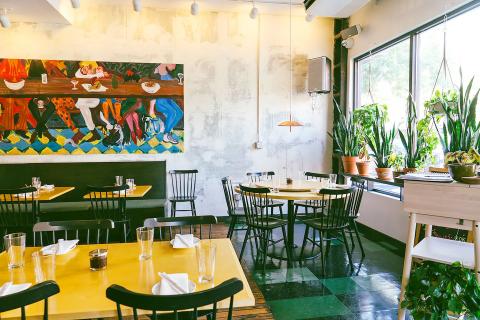
Photo courtesy of Win Son
But search in places like the hip East Village in Manhattan or Williamsburg in Brooklyn, and a foodie would find the pickings slim.
That shows signs of changing.
TAIWANESE DELICACIES
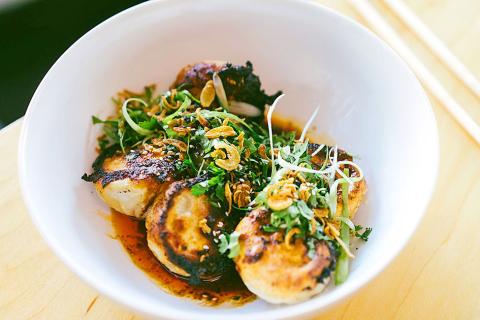
Photo courtesy of Win Son
Ho joins a number of young restaurateurs introducing a wider cross-section of New Yorkers to such Taiwanese delights as beef noodle soup (牛肉麵), century egg and tofu (涼拌皮蛋豆腐), oyster omelette (蚵仔煎) and stinky tofu (臭豆腐).
His restaurant, Ho Foods (何家麵店), which specializes in beef noodle soup, just opened in January, fulfilling a lifelong dream.
“I always get the sense that it’s always been bubbling, kind of there,” Ho said, referring to people’s interest in Taiwanese food. “There’s always so many people talking about it, and for some reason everyone took action this year.”
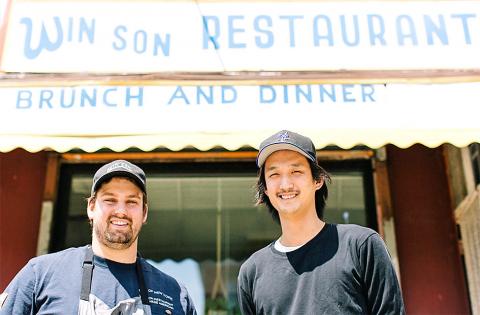
Photo courtesy of Win Son
Exact figures aren’t known on just how many Taiwanese restaurants operate in New York City today. Online searches in English and Chinese turn up at least a dozen or so, though the actual number could be higher. Some restaurants have closed and new ones opened as the city’s Taiwanese demographic has shifted.
Census estimates from 2016 show there were just over 11,000 Taiwanese living in New York City, whose total population is 8.6 million.
Brothers Eddie and Evan Huang helped blaze a trail for transporting Taiwanese food beyond the city’s Chinatowns when they opened up Baohaus in 2009 on Manhattan’s trendy Lower East Side. The eatery, known for its guabao (割包) steamed buns, has since moved to East 14th Street near Union Square.
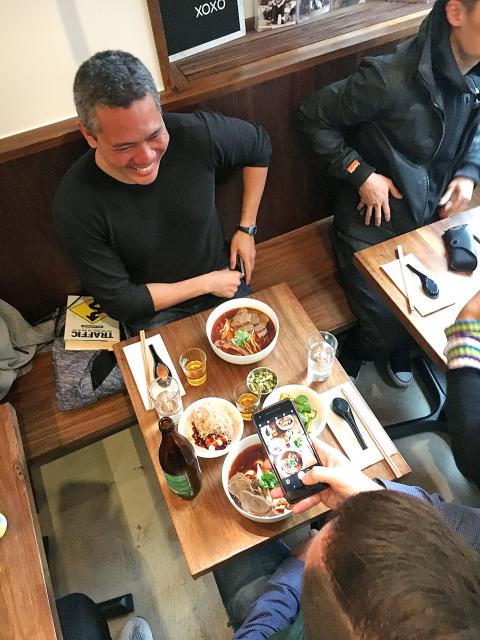
Photo: Chris Fuchs
Meanwhile, as New Yorkers were getting their fill of Asian noodle dishes like Japanese ramen and Vietnamese pho, Josh Ku (顧文宇) and Trigg Brown were forging a friendship that began at a cookout in Brooklyn.
That bond led to their opening a Taiwanese-American restaurant in May 2016 called Win Son, located in the borough’s hipster East Williamsburg section.
As 30-year-old Ku tells it, that was never their intention.
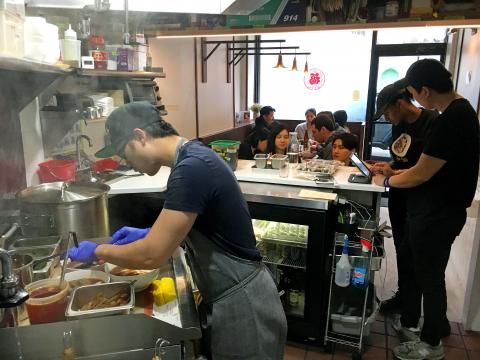
Photo: Chris Fuchs
“We didn’t really have any object or goal besides just trying to eat,” said Ku, a Taiwanese American who grew up on Long Island.
Ku and 29-year-old Brown built up their friendship as they ate their way through parts of Queens. Brown, a chef from Virginia, said even though he didn’t have an expansive understanding of Taiwan, he was interested in the food.
“Each dish seemed to carry a unique historical significance,” Brown said. “Some of the significance had roots in different parts of China and some of them had roots that were very idiosyncratic to Taiwan. We were naturally learning a lot about the food just through our interest in eating.”
WIN SON
The idea to open Win Son came while Ku was managing the building that today houses their restaurant. As he was preparing to rent out the space, Ku said he noticed that the restaurateurs interested in it proposed paying below the landlord’s asking price.
“I knew some of these guys that had successful restaurants, and was like, if these guys can do it, why not us,” Ku explained.
The restaurant’s location in an up-and-coming neighborhood, Ku reasoned at the time, could generate the income needed to survive while introducing Taiwanese cuisine to customers unfamiliar with it.
Win Son’s menu features staples like scallion pancake (蔥油餅), stinky tofu and oyster omelette, as well as fly’s head (蒼蠅頭, stir-fried minced pork with Chinese chives and fermented black beans) and braised pork rice bowl (滷肉飯).
Other creations include the “nutritious sandwich” (營養三明治), a take on the night market snack popularized in Keelung. Win Son’s is made with shrimp cake, pickled pineapple and fried dough.
“Based on my experience and looping it through my New American lens, we kind of understood that the food was going to be not dumbed down or bastardized, but we were going to make smart decisions,” Brown said.
Ku and Brown have traveled together to Taiwan several times for research.
“A lot of what we sort out was food and eating and seeing how people put the food together, but also just hanging out and experiencing the culture, people our age, and what they’re doing,” Ku said.
Win Son’s customer base spans the gamut, according to Ku, ranging from people of Taiwanese and Chinese descent to others who know nothing about Taiwanese food.
Ku said they originally thought their biggest critics would be the Taiwanese and Chinese patrons.
“Actually, they’ve been our biggest supporters,” Ku said. “Our biggest critics are American-born Taiwanese, Chinese people, with this idea of lack of authenticity and saying things like, you can go to Chinatown and get this for half the price.”
While Ku and Brown have been at it for sometime now, Ho Foods is a relative newcomer, serving up Taiwanese fare in the East Village for almost three months.
The cozy space on East 7th Street features a simple menu: beef noodle with varying levels of richness and spiciness, as well as sides like soy cucumbers and soft tofu with century egg.
On a recent Friday night, just after opening around 5pm, patrons were already milling around outside as a drizzle fell, jockeying for one of the dozen-or-so seats inside.
Todd Fellerman, a 35-year-old who lives nearby, was lucky enough to nab a table with his friend, Reuthanak Tap.
Fellerman said that while he’s traveled a lot, he’s never been to Taiwan. It was also his first time trying Taiwanese beef noodle soup.
“Really delicious,” Fellerman said after a few bites. “Right amount of spice, savory, everything was tender.”
Interestingly enough, Trevor Liu (劉冠谷), the 25-year-old chef born in Taiwan who was dishing out the orders, said he didn’t eat a lot of beef noodle soup growing up. That’s because his father is a Buddhist.
Nonetheless, it has a special place in his heart.
“It represents a lot of who we are,” Liu said.
CULINARY MELTING POT
In Taiwan’s early agrarian days, the nation’s inhabitants typically didn’t consume beef since cows were seen as valuable on a farm. That began to change after soldiers fighting for Chiang Kai-shek’s (蔣介石) Republic of China army and their families evacuated to Taiwan in 1949, following the Chinese Civil War.
It is generally believed that Taiwan’s beef noodle soup was created in the country’s military villages by chefs from China, many from Sichuan Province, who traveled across the Taiwan Strait with the soldiers.
As food trends come and go in a city known for its gastronomic diversity, Ho believes Taiwanese food is not a passing fad. Other Taiwanese restaurants have been popping up in New York in unexpected parts of town — and more appear on the way.
“Taiwanese food has been around for so long that it was never a gimmick to begin with,” said Ho, who had opened pop-ups before his East Village location. “And I don’t think it will ever turn into that.”
As for what’s been driving the recent uptick, Ku had some theories.
“A small part of it has to do with a generational evolution of immigrants to professionals, and job security versus creative pursuits,” he speculated.
Role models also play a role, Ku said. He cited the story of Brooklyn Nets point guard Jeremy Lin (林書豪), a Taiwanese American who graduated Harvard and faced an uphill battle making it into the NBA because of Asian stereotypes.
“He did all these things that your parents would love for you to do, but he also pursued something that was totally not recommended by anyone,” Ku said.

June 9 to June 15 A photo of two men riding trendy high-wheel Penny-Farthing bicycles past a Qing Dynasty gate aptly captures the essence of Taipei in 1897 — a newly colonized city on the cusp of great change. The Japanese began making significant modifications to the cityscape in 1899, tearing down Qing-era structures, widening boulevards and installing Western-style infrastructure and buildings. The photographer, Minosuke Imamura, only spent a year in Taiwan as a cartographer for the governor-general’s office, but he left behind a treasure trove of 130 images showing life at the onset of Japanese rule, spanning July 1897 to

One of the most important gripes that Taiwanese have about the Democratic Progressive Party (DPP) is that it has failed to deliver concretely on higher wages, housing prices and other bread-and-butter issues. The parallel complaint is that the DPP cares only about glamor issues, such as removing markers of Chinese Nationalist Party (KMT) colonialism by renaming them, or what the KMT codes as “de-Sinification.” Once again, as a critical election looms, the DPP is presenting evidence for that charge. The KMT was quick to jump on the recent proposal of the Ministry of the Interior (MOI) to rename roads that symbolize

On the evening of June 1, Control Yuan Secretary-General Lee Chun-yi (李俊俋) apologized and resigned in disgrace. His crime was instructing his driver to use a Control Yuan vehicle to transport his dog to a pet grooming salon. The Control Yuan is the government branch that investigates, audits and impeaches government officials for, among other things, misuse of government funds, so his misuse of a government vehicle was highly inappropriate. If this story were told to anyone living in the golden era of swaggering gangsters, flashy nouveau riche businessmen, and corrupt “black gold” politics of the 1980s and 1990s, they would have laughed.

Imagine being able to visit a museum and examine up close thousand-year-old pottery, revel alone in jewelry from centuries past, or peer inside a Versace bag. Now London’s V&A has launched a revolutionary new exhibition space, where visitors can choose from some 250,000 objects, order something they want to spend time looking at and have it delivered to a room for a private viewing. Most museums have thousands of precious and historic items hidden away in their stores, which the public never gets to see or enjoy. But the V&A Storehouse, which opened on May 31 in a converted warehouse, has come up